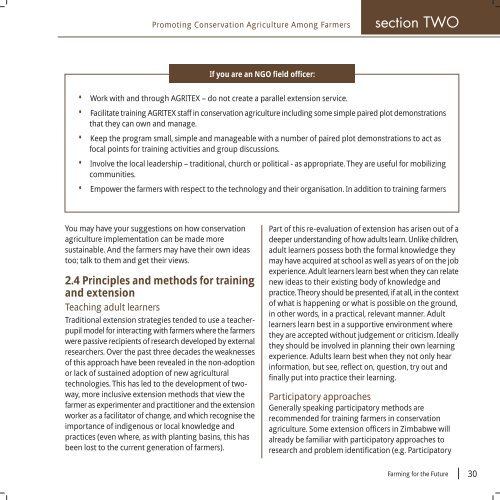A Guide to Conservation Agriculture in Zimbabwe - Canadian ...
A Guide to Conservation Agriculture in Zimbabwe - Canadian ...
A Guide to Conservation Agriculture in Zimbabwe - Canadian ...
You also want an ePaper? Increase the reach of your titles
YUMPU automatically turns print PDFs into web optimized ePapers that Google loves.
Promot<strong>in</strong>g <strong>Conservation</strong> <strong>Agriculture</strong> Among Farmers<br />
section TWO<br />
If you are an NGO field officer:<br />
• Work with and through AGRITEX – do not create a parallel extension service.<br />
• Facilitate tra<strong>in</strong><strong>in</strong>g AGRITEX staff <strong>in</strong> conservation agriculture <strong>in</strong>clud<strong>in</strong>g some simple paired plot demonstrations<br />
that they can own and manage.<br />
• Keep the program small, simple and manageable with a number of paired plot demonstrations <strong>to</strong> act as<br />
focal po<strong>in</strong>ts for tra<strong>in</strong><strong>in</strong>g activities and group discussions.<br />
• Involve the local leadership – traditional, church or political - as appropriate. They are useful for mobiliz<strong>in</strong>g<br />
communities.<br />
• Empower the farmers with respect <strong>to</strong> the technology and their organisation. In addition <strong>to</strong> tra<strong>in</strong><strong>in</strong>g farmers<br />
You may have your suggestions on how conservation<br />
agriculture implementation can be made more<br />
susta<strong>in</strong>able. And the farmers may have their own ideas<br />
<strong>to</strong>o; talk <strong>to</strong> them and get their views.<br />
2.4 Pr<strong>in</strong>ciples and methods for tra<strong>in</strong><strong>in</strong>g<br />
and extension<br />
Teach<strong>in</strong>g adult learners<br />
Traditional extension strategies tended <strong>to</strong> use a teacherpupil<br />
model for <strong>in</strong>teract<strong>in</strong>g with farmers where the farmers<br />
were passive recipients of research developed by external<br />
researchers. Over the past three decades the weaknesses<br />
of this approach have been revealed <strong>in</strong> the non-adoption<br />
or lack of susta<strong>in</strong>ed adoption of new agricultural<br />
technologies. This has led <strong>to</strong> the development of twoway,<br />
more <strong>in</strong>clusive extension methods that view the<br />
farmer as experimenter and practitioner and the extension<br />
worker as a facilita<strong>to</strong>r of change, and which recognise the<br />
importance of <strong>in</strong>digenous or local knowledge and<br />
practices (even where, as with plant<strong>in</strong>g bas<strong>in</strong>s, this has<br />
been lost <strong>to</strong> the current generation of farmers).<br />
Part of this re-evaluation of extension has arisen out of a<br />
deeper understand<strong>in</strong>g of how adults learn. Unlike children,<br />
adult learners possess both the formal knowledge they<br />
may have acquired at school as well as years of on the job<br />
experience. Adult learners learn best when they can relate<br />
new ideas <strong>to</strong> their exist<strong>in</strong>g body of knowledge and<br />
practice. Theory should be presented, if at all, <strong>in</strong> the context<br />
of what is happen<strong>in</strong>g or what is possible on the ground,<br />
<strong>in</strong> other words, <strong>in</strong> a practical, relevant manner. Adult<br />
learners learn best <strong>in</strong> a supportive environment where<br />
they are accepted without judgement or criticism. Ideally<br />
they should be <strong>in</strong>volved <strong>in</strong> plann<strong>in</strong>g their own learn<strong>in</strong>g<br />
experience. Adults learn best when they not only hear<br />
<strong>in</strong>formation, but see, reflect on, question, try out and<br />
f<strong>in</strong>ally put <strong>in</strong><strong>to</strong> practice their learn<strong>in</strong>g.<br />
Participa<strong>to</strong>ry approaches<br />
Generally speak<strong>in</strong>g participa<strong>to</strong>ry methods are<br />
recommended for tra<strong>in</strong><strong>in</strong>g farmers <strong>in</strong> conservation<br />
agriculture. Some extension officers <strong>in</strong> <strong>Zimbabwe</strong> will<br />
already be familiar with participa<strong>to</strong>ry approaches <strong>to</strong><br />
research and problem identification (e.g. Participa<strong>to</strong>ry<br />
Farm<strong>in</strong>g for the Future<br />
30
















